感谢肖为本文提供英文朗读录音,点击上方音频可听。Thank Shaw for his English reading recording. You can listen to it by clicking the audio above.

(Image from the website of Hunan Museum)
2024年7月,许久未出远门的我,得知马王堆出土的一件素纱褝衣在湖南博物院首次展出。我本来也想去那里很久了,于是就背起背包,去做了两周数字游民。
In a long-time-no-travel July, I happened to know that the famous gauze gown unearthed from Mawangdui was on display at Hunan Museum for the very first time. This museum was on my list, so I went to Changsha with my backpack as a digital nomad.
早闻湖南博物院很难预约,一位长沙的朋友说给我留了特展赠券,可以直接入馆,我便只约了另一个特展,就是让这件素纱褝衣首次与观众见面的“彼美人兮——两汉罗马时期女性文物展”。
I‘ve heard about the hardness of reserving a slot to enter the Hunan Museum. Luckily, a friend of mine in Changsha told me that she left me a coupon for a special exhibition, with which I could enter the museum without reservation. I then booked a ticket for another one, She Walks in Beauty, in which the gauze gown was shown to the public.

(图片来源:湖南博物院官网)
Poster of SHE WALKS IN THE BEAUTY
(Image from the website of Hunan Museum)
此展将中国汉代和西方罗马帝国时期的一些文物放到一起,试图反映东西方文化强盛时代的女性生活概貌与社会角色。这些东西都与女性和她们的生活有关,其中包括几件马王堆出土文物,素纱褝衣为其中之一。
In this exhibition, ancient objects from both Han Dynasty in China and Roman Empire in the West were displayed together, attempting to show the living conditions and societal roles of females in times of cultural prosperity. All the stuff links to females and their lives, including several antiquities from Mawangdui, such as the gauze gown.
去了才知道,这次号称首次展出的素纱褝衣,是马王堆出土两件褝衣中的其中一件,而另一件在博物馆的马王堆陈列中常年展览。两件衣服凭肉眼看极为相似,非要找不同的话,常展的那件是直裾形制,而首次展出的这件是曲裾。肉眼看不见的区别除了具体的丝线,大概只在于重量,前者49g,后者48g。
I had no idea until I went to the exhibition that this first shown gauze gown was only one of the two unearthed. And the other one is displayed in the museum permanently. The two gowns resemble each other. If one does want to find a difference, the permanently exhibited one has a curving-front shape while the specially shown one is straight-front. And apart from the exact threads of them, the only difference between might lies in their weights, 49g for the permanently displayed one and 1g less for the other.

The 48g curving-front gauze gown and its partial details

The 49g straight-front gauze gown
这两件衣服之所以闻名,就是因为它们极为轻质的重量和薄如蝉翼的外观,所用蚕丝线极细。据说由于现在的家蚕已演化得比过去肥壮许多,再难产出如此细丝,所以要复制素纱褝衣极为困难。不过对参观者来说,1g的差别无关紧要,无论看哪一件,都能一饱眼福。错过了特展上的48g曲裾褝衣,还是可以去看常展的49g直裾褝衣的。
These two gowns stood out literally because of their extremely lightweight and translucent outlook as thin as the cicada wings. Their silk threads are extremely fine, hard to reproduce because silkworms today have evolved to be stronger and bigger than that in the past. Nevertheless, the 1g makes no difference for visitors. Each of the two would be a feast for the eyes. If you missed the 48g curving-front gauze gown on the special exhibition, you can also visit the 49g straight-front one on the permanent part.
不过,特展只是我这次来参观的一个由头,马王堆出土文物也不是只有在这个特展上才能看到。湖南博物院最大的看点,是占了好几层楼的常展“长沙马王堆汉墓陈列”,除了品类丰富的墓葬遗物,还展览着一号墓主人辛追的遗体。
Even so, the special exhibition was just a small reason for my visit. Antiquities unearthed from Mawangdui are not shown exclusively on it. The biggest attraction here in Hunan Museum, is the permanent CHANGSHA MA WANGDUI HAN DYNASTY TOMBS EXHIBITION that occupies several floors. In addition to diverse relics from the tombs, Xin Zhui’s corpse is also on display.
在马王堆发现的墓葬一共有三座,墓主为西汉时期长沙国丞相轪侯利苍一家。辛追是利苍的夫人,葬于马王堆一号墓内,被发掘时是保存完好的软体湿尸……当然,这也不是我本人的兴趣所在,我关注的是辛追墓出土的纺织品。
Three tombs were discovered in Mawangdui in Changsha, Hunan Province, the owners of which are family members of Li Cang, Marquis Dai, the prime minister of State Changsha in the West Han Dynasty. Xin Zhui, his wife, buried in Tomb 1, was discovered as a well-preserved, soft, wet corpse…And this is surely not where my interest lies. What I pay more attention to are textiles excavated from Xin Zhui‘s tomb.
对中国古代纺织品有所了解的人,不会不知道马王堆。那里出土的织物,无论是与同时代其它考古发现相比,还是在古老的中国历史长河中,都堪称海量。以至于在惯常的考古报告之外,这里还出了专门针对纺织品的厚书《长沙马王堆一号汉墓出土纺织品的研究》(1980)、《马王堆汉墓服饰研究》(2018)和《马王堆一号汉墓纺织品》(2024)。
People who know about ancient Chinese textiles must have heard about Mawangdui, where massive textiles were excavated. Aside from normal archaeological reports, thick books regarding textiles unearthed here were also published (no English version yet).
这些纺织品几乎都出自辛追的墓中,除了几百件丝织物,也有几十件麻布和一些麻绳。织物来自于衣物、敛葬用布、覆盖物、帛书等,还有一些碎布是作为聂币,出土于辛追墓西边厢的竹笥内。据介绍,这些聂币既可能是自备或赙赠的随葬明器,也可能是丧葬中用的祭奠之物,作为布帛的替代品,引申为财富象征。
Most of these textiles were buried with Xin Zhui, including hundreds of silk products, tens of bast fabrics, and several bast strings. They are used for clothing, funerals, covering, documents, etc. Among them, fragmented fabrics were found in a bamboo basket in the west chamber, said to be niebi probably used as funeral objects symbolizing wealth and properties.
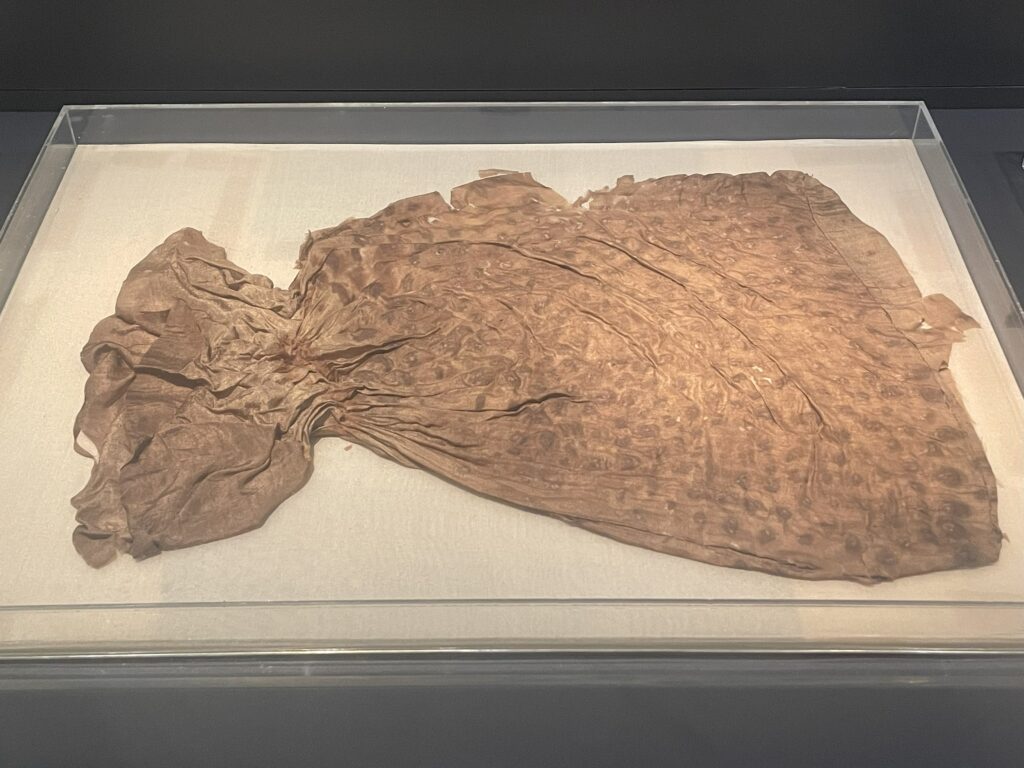
A silk bag unearthed from Xin Zhui’s tomb(with ceramic pearls when discovered)

One of the bamboo baskets unearthed from Xin Zhui’s tomb

Tags on the bamboo baskets

Niebi probably used as funeral objects symbolizing wealth and properties
在湖南博物院,素纱褝衣固然惊艳,丝织物与帛书也用丰富的品类、斑斓的纹样和携带的信息量,令人目不暇接。不过在这场文物盛宴里,我自己最想看的东西既不是素纱褝衣也不是帛书或丝织物,而是展出的苎麻布和大麻布样本。
In the Hunan Museum, the gauze gown is amazing. Silk products overwhelmed me with their diverse types, intricate patterns, and numerous information on them. However, in this feast of cultural relics, what I wanted to see the most was not the gown, either silk paintings or other products, but the samples of ramie and hemp fabrics.
2021年在韩国,我才知道传统苎麻线的制作和我本科时学的纺纱原理不是同一种操作。纺纱的基本原理是将纤维集束,然后一边牵伸一边加捻,这对于棉花、羊毛、亚麻等其它短纤维来说都是适用的。苎麻的单纤维较长,也可以被打成短纤维后经同样的处理进行纺纱,但传统的苎麻线是将苎麻的韧皮劈分后,将纤细的麻缕一根根首尾绩接而成。这种方法,至今还未能被机械代劳。
Back in 2021, when I was in South Korea, I learned that the traditional ramie thread-making method was not the same as spinning that I learned in university. The way of spinning is to collect the fibres, twisting them while drafting. This method applies to short fibres such as cotton, wool, flax, etc. As for ramie, it can be processed in the same way even with long fibres, but the traditional method of making its thread is to split its bast into fine strips, and then splice the strips end to end. Until today, this method has not been superseded by machines.
背景就不展开说了,眼前的结果是,马王堆出土的苎麻布所用麻线是否由麻缕首尾绩接而成,对我来说非常重要。官方报告从未点明这一信息,此前我只在网帖中看到有人这么说,却无法通过图片判断。得知马王堆出土的麻布中,有样品一直在湖南博物院常年展览,我曾试图找人帮我拍高清照片,却未能实现,同时也很难让外行理解我的需求(无意冒犯)。
I would not introduce the background here. The thing was, I wanted to know whether the threads in the Mawangdui ramie cloth were made in a splicing way. I never found this information in the official reports. Someone on the internet stated this but I failed to verify it through the picture. Knowing that some samples are displayed in Hunan Museum permanently, I tried to ask someone to help me take HD photos but failed again. Moreover, no offence here, but it is very hard to make somebody unprofessional understand what I need.
我一直很想亲自观察,此次终于成行。我按“长沙马王堆汉墓陈列”的顺序依次参观,将记忆里在考古报告里读到的信息与实物对应,不得不说,体验甚佳。连木俑都穿着定制服装,这在我的经验里还是头一回见。
I had always been looking forward to observing the cloth by myself, and finally made it. I visited the exhibition following its routes, and linked the virtual objects with information in my head. It was fantastic. Even the wooden tomb figures were clothed with textiles.
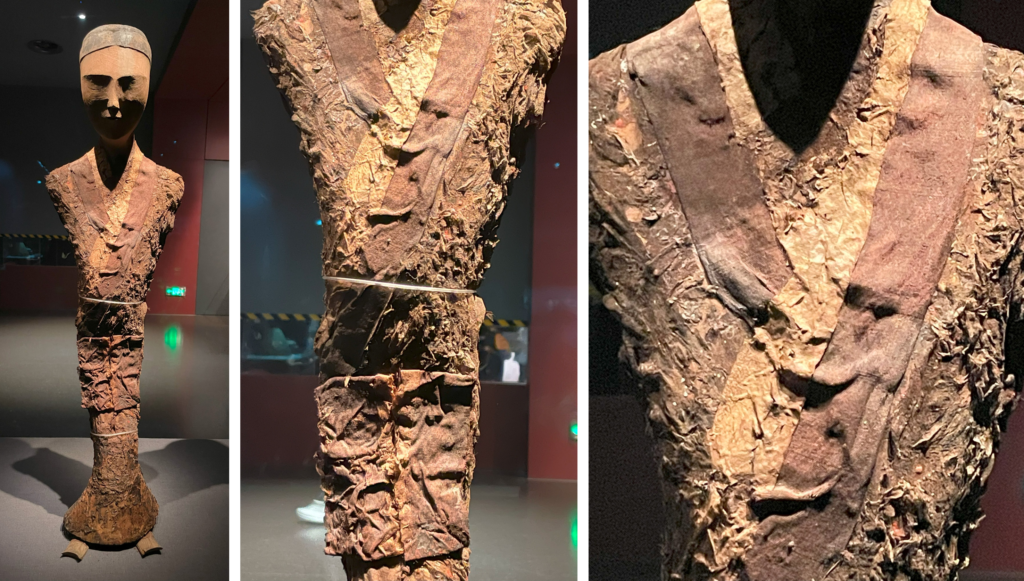
A clothed female servant figurine and its clothes

A clothed female singer figurine on the special exhibition
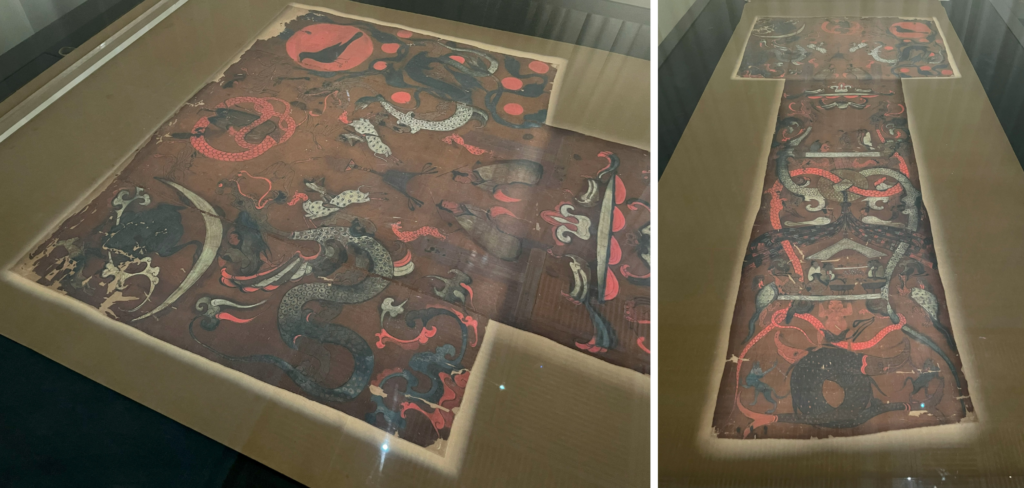
T-shaped painting on silk from Xin Zhui’s tomb

Book copied on silk, Divination by Astrological and Meteorological Phenomena
快到展览的尽头时,有一个展厅专门对纺织品进行了陈列。对比展板给出的统计数据,可知这里展出的织物只是冰山一角,但展陈的规模也算是很大。只可惜看不清楚,因为光线实在太暗。就像一个有钱人拿给你看他鼓囊囊的包,你却完全看不清它里面到底装了些什么。
Near the end of this exhibition, there is a hall exhibiting textiles specifically. Compared with the information on the wall, these on display were just a small part of the total unearthed from Mawangdui, though still a large amount. One bad thing is, this room is too dim for visitors to see carefully. It feels like a wealthy person shows you a bulging bag but you can never see what he has.
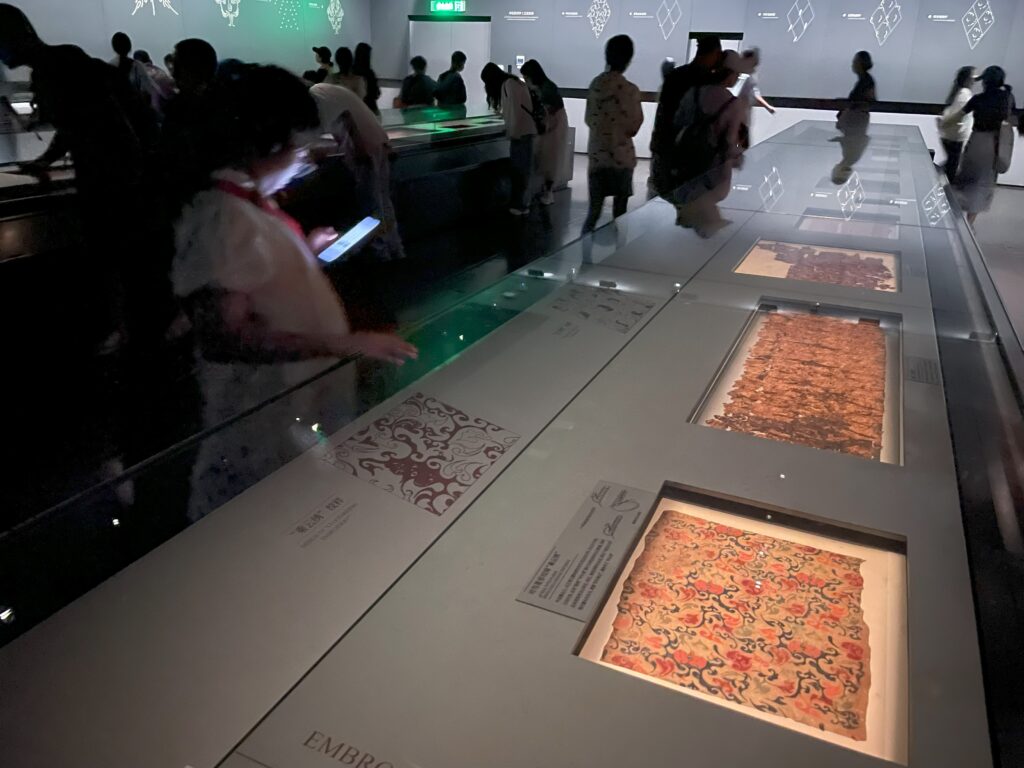
A textile room of the Mawangdui exhibition
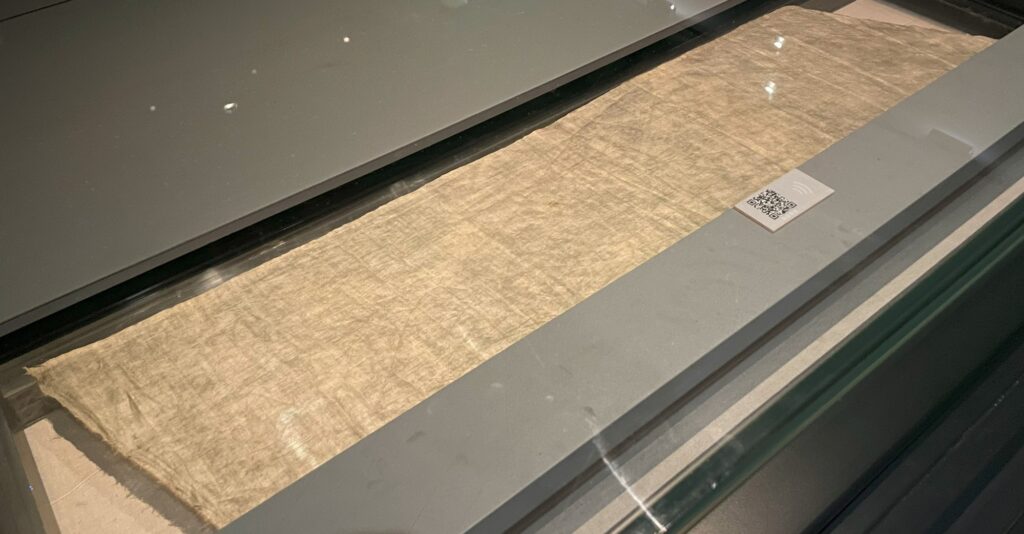
One of the grey ramie cloths unearthed from Xin Zhui’s tomb

One of the white ramie cloths unearthed from Xin Zhui’s tomb
这对我观察麻布细节造成了影响,但更强烈的失落,还是这面料的精细度让我根本看不出线材的形态。我将手机镜头倍数放到最大,也看不清我想要的细节。
This condition affected my observing the cloth. But what frustrated me even more was that the cloth’s fineness hid its threads’ shape. I zoomed my phone camera to its maximum level, but still could not see the details I wanted.
我曾在联系国内博物馆想要近距离观察文物这件事上,吃了很多闭门羹,所以尽量从开放获取的资源挖掘信息,却依然失败,只得继续在昏暗的展厅看看花色纹样。如果对技术细节没有需求,湖南博物院展出的马王堆出土纺织品,还是称得上为一场织物盛宴的。
I had been rejected a lot in my attempts to contact domestic museums for a closer observation of textile relics. As a result, I prefer using open-access resources to extract information. Yet, my effort that day failed, leaving me no choice but to continue watching the patterns and designs in the dimly lit hall. Nevertheless, if one does not require technical details, the textiles unearthed from Mawangdui and displayed at the Hunan Museum can still indeed be a visual feast.
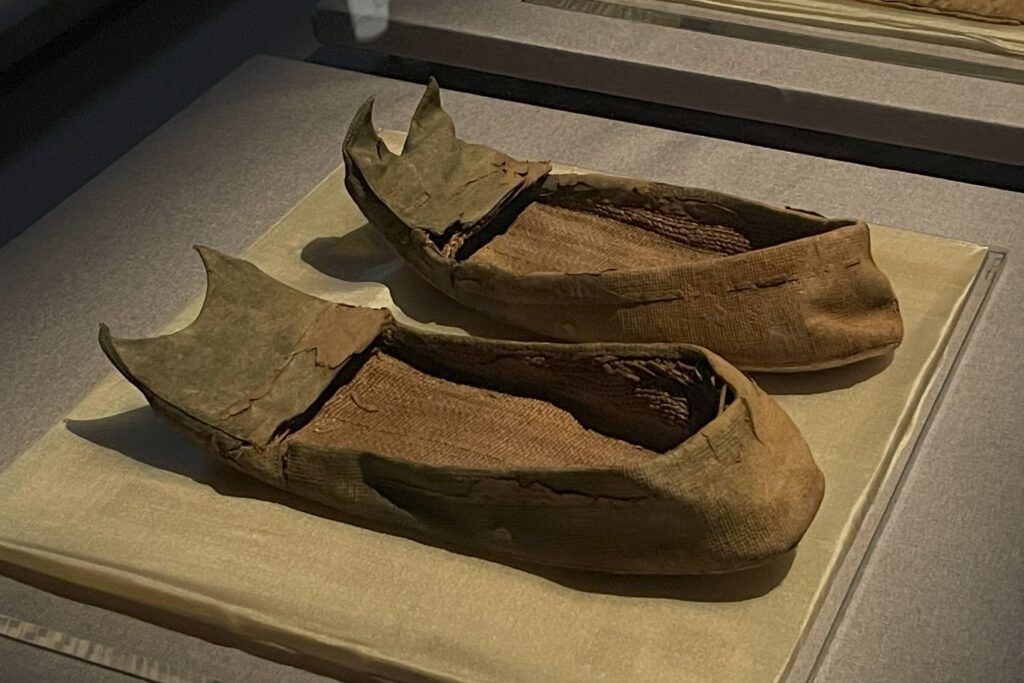
A pair of shoes from Mawangdui
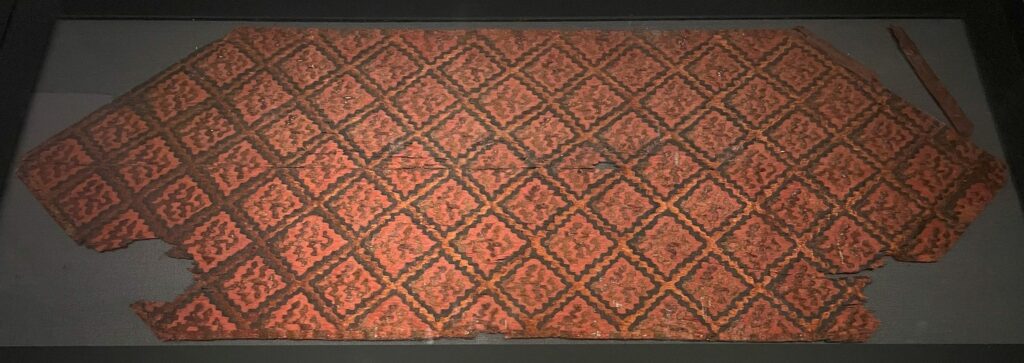
Embroidered silk with tree pattern

A partial detail on the embroidered silk with tree pattern